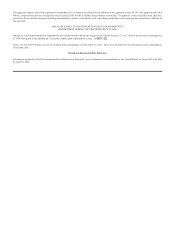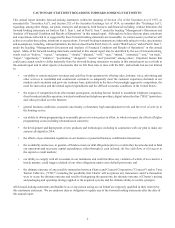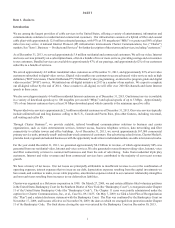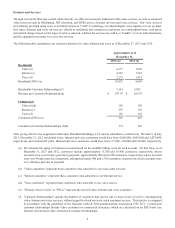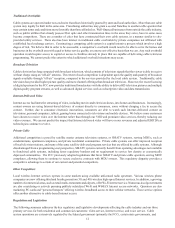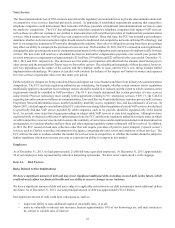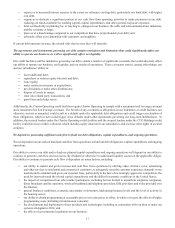Charter 2013 Annual Report Download - page 21
Download and view the complete annual report
Please find page 21 of the 2013 Charter annual report below. You can navigate through the pages in the report by either clicking on the pages listed below, or by using the keyword search tool below to find specific information within the annual report.7
Charter has deployed Enhanced TV Binary Interchange Format (“EBIF”) technology to set-top boxes in most service areas within
the Charter footprint. EBIF is a technology foundation that will allow Charter to deliver enhanced and interactive television
applications and enable our video customers to use their remote control to interact with their television programming and its
advertisements. EBIF will enable Charter’s customers to request such items as coupons, samples, and brochures from advertisers.
From time to time, certain of our vendors, including programmers and equipment vendors, have purchased advertising from us.
For the years ending December 31, 2013, 2012 and 2011, we had advertising revenues from vendors of approximately $41 million,
$59 million and $51 million, respectively. These revenues resulted from purchases at market rates pursuant to binding agreements.
Pricing of Our Products and Services
Our revenues are derived principally from the monthly fees customers pay for the services we provide. We typically charge a
one-time installation fee which is sometimes waived or discounted during certain promotional periods. The prices we charge for
our products and services vary based on the level of service the customer chooses and in some cases the geographic market. In
accordance with Federal Communications Commission ("FCC") rules, the prices we charge for video cable-related equipment,
such as set-top boxes and remote control devices, and for installation services, are based on actual costs plus a permitted rate of
return in regulated markets.
In mid-2012, Charter launched a new pricing and packaging approach which emphasizes the triple play products of video, Internet
and voice services and combines our most popular services in core packages at a fair price. We believe the benefits of this new
approach are:
• simplicity for both our customers in understanding our offers, and our employees in service delivery;
• the ability to package more services at the time of sale and include more product in each service, thus increasing revenue
per customer;
• higher product offering quality through more HD channels, improved pricing for HD and HD/DVR equipment and faster
Internet speeds;
• lower expected churn as a result of higher customer satisfaction; and
• gradual price increases at the end of promotional periods.
As of December 31, 2013, approximately 64% of our customers, or 68% excluding those acquired in the acquisition of Bresnan,
are in the new pricing and packaging plan.
Our Network Technology
Our network includes three components: the national backbone, regional/metro networks and the "last-mile" network. Both our
national backbone and regional/metro network components utilize or plan to utilize a redundant Internet Protocol ("IP”) ring/mesh
architecture with the capability to differentiate quality of service for each residential or commercial product offering. The national
backbone provides connectivity from the regional demarcation points to nationally centralized content, connectivity and services.
The regional/metro network components provide connectivity between the regional demarcation points and headends within a
specific geographic area and enable the delivery of content and services between these network components.
Our last-mile network utilizes a traditional hybrid fiber coaxial cable (“HFC”) architecture, which combines the use of fiber optic
cable with coaxial cable. In most systems, we deliver our signals via fiber optic cable from the headend to a group of nodes, and
use coaxial cable to deliver the signal from individual nodes to the homes served by that node. For our fiber Internet, Ethernet,
carrier wholesale, SIP and PRI commercial customers, fiber optic cable is extended from the individual nodes all the way to the
customer's site. On average, our system design enables up to 340 homes passed to be served by a single node and provides for
six strands of fiber to each node, with two strands activated and four strands reserved for spares and future services. We believe
that this hybrid network design provides high capacity and signal quality. The design also provides two-way signal capacity for
the addition of further interactive services.
HFC architecture benefits include:
• bandwidth capacity to enable traditional and two-way video and broadband services;
• dedicated bandwidth for two-way services, which avoids return signal interference problems that can occur with two-
way communication capability; and
• signal quality and high service reliability.



